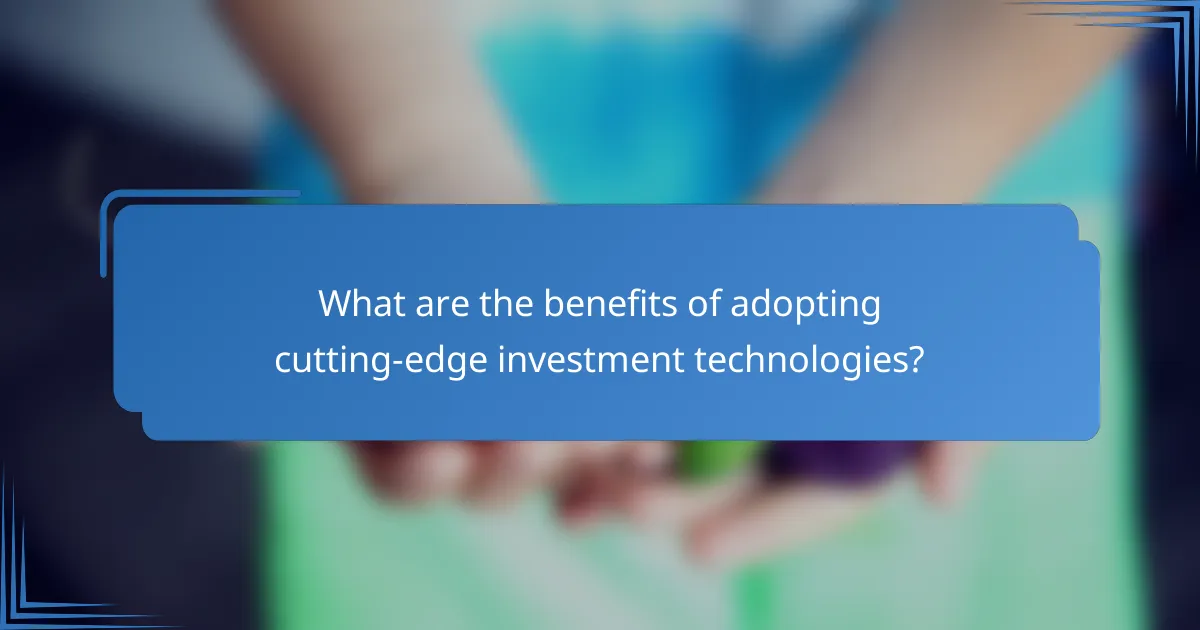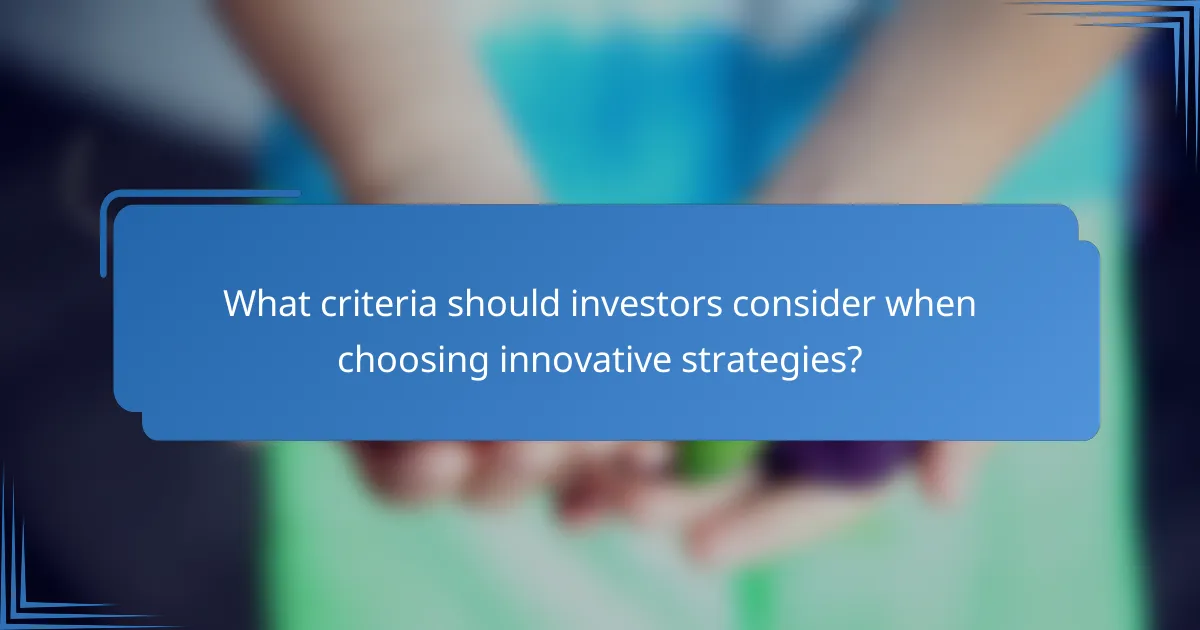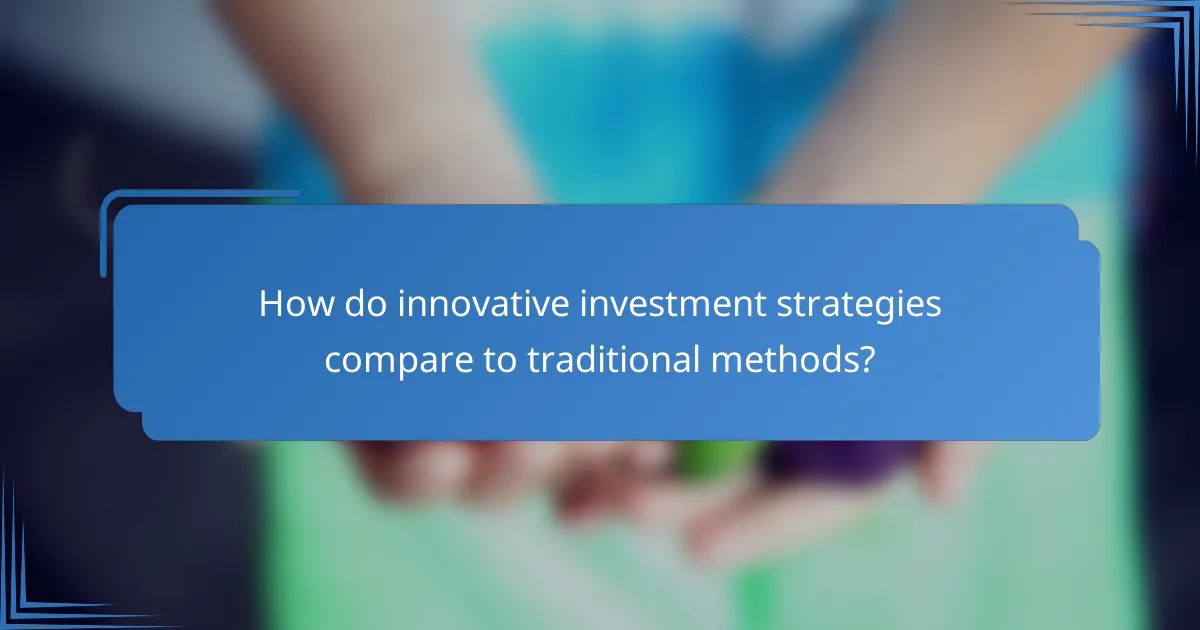Innovative investment strategies are revolutionizing the financial landscape by harnessing cutting-edge technologies such as artificial intelligence, blockchain, and robo-advisors. These advancements not only enhance portfolio management but also empower investors with sophisticated tools for data analysis and market forecasting, enabling more informed decision-making. By adopting these technologies, investors can achieve greater efficiency, reduce risks, and uncover profitable opportunities in an increasingly competitive market.

What innovative investment strategies are emerging in Australia?
Innovative investment strategies in Australia are increasingly leveraging cutting-edge technologies to gain a competitive edge. Key areas include artificial intelligence, blockchain, and robo-advisors, which are transforming traditional investment approaches and enhancing portfolio management.
Artificial Intelligence in Stock Trading
Artificial intelligence (AI) is revolutionizing stock trading by enabling algorithms to analyze vast amounts of data quickly and accurately. These AI systems can identify patterns and trends that human traders might miss, allowing for more informed decision-making.
Investors can utilize AI-driven platforms to automate trading strategies, reducing the emotional biases that often lead to poor investment choices. However, it’s essential to remain cautious, as reliance on AI can lead to overfitting models to historical data, which may not predict future performance accurately.
Blockchain for Real Estate Investments
Blockchain technology is making waves in real estate investments by providing a secure and transparent way to record transactions. This decentralized ledger system can streamline property transfers, reducing the need for intermediaries and lowering transaction costs.
In Australia, blockchain can facilitate fractional ownership, allowing investors to buy shares in properties rather than whole assets. This approach can democratize access to real estate investments, but investors should be aware of the regulatory landscape, as it is still evolving.
Robo-Advisors for Personalized Portfolios
Robo-advisors are automated platforms that create and manage investment portfolios based on individual risk tolerance and financial goals. These services use algorithms to optimize asset allocation, making investing more accessible and affordable for Australians.
While robo-advisors can offer low fees and diversification, investors should ensure they understand the underlying investment strategies and fees associated with these platforms. Regularly reviewing portfolio performance and adjusting risk levels is also crucial for long-term success.

How can technology enhance investment decision-making?
Technology enhances investment decision-making by providing advanced tools for data analysis, risk assessment, and market forecasting. These innovations help investors make informed choices, reduce risks, and identify profitable opportunities more efficiently.
Data Analytics for Market Trends
Data analytics enables investors to analyze vast amounts of market data to identify trends and patterns. By leveraging historical data and real-time information, investors can make predictions about future market movements.
Tools such as sentiment analysis and predictive modeling can help in understanding market dynamics. For example, analyzing social media trends can provide insights into public sentiment towards specific stocks or sectors, which can influence investment strategies.
Machine Learning for Risk Assessment
Machine learning algorithms can significantly improve risk assessment by analyzing complex datasets to identify potential risks associated with investments. These systems learn from historical data to predict future outcomes, allowing investors to make more informed decisions.
For instance, a machine learning model might evaluate various factors such as market volatility, economic indicators, and company performance to assess the risk level of a particular asset. This can help investors avoid high-risk investments and optimize their portfolios.

What are the benefits of adopting cutting-edge investment technologies?
Adopting cutting-edge investment technologies offers significant advantages, including improved efficiency and enhanced decision-making capabilities. These technologies streamline trading processes and provide investors with tools to better analyze and diversify their portfolios.
Increased Efficiency in Trades
Cutting-edge investment technologies, such as algorithmic trading and high-frequency trading platforms, can execute trades in milliseconds, far surpassing human capabilities. This speed allows investors to capitalize on market opportunities that might otherwise be missed.
Additionally, automation reduces the likelihood of human error, ensuring that trades are executed according to predefined strategies. Investors can set parameters for trades, allowing for consistent execution without the need for constant monitoring.
Enhanced Portfolio Diversification
Advanced technologies enable investors to analyze vast amounts of data, identifying trends and correlations that inform diversification strategies. By utilizing machine learning algorithms, investors can uncover new asset classes or sectors that align with their risk tolerance and investment goals.
For example, robo-advisors can automatically create and manage diversified portfolios based on individual preferences and market conditions. This approach not only spreads risk but also enhances the potential for returns across different market environments.

What criteria should investors consider when choosing innovative strategies?
Investors should evaluate factors such as market potential, technological viability, and regulatory landscape when selecting innovative investment strategies. Understanding these criteria helps in identifying opportunities that can yield competitive advantages in rapidly evolving markets.
Regulatory Compliance in Australia
In Australia, regulatory compliance is crucial for any innovative investment strategy. Investors must familiarize themselves with the Australian Securities and Investments Commission (ASIC) guidelines, which govern financial products and services. Non-compliance can lead to significant penalties and hinder investment opportunities.
Additionally, staying updated on changes in regulations related to emerging technologies, such as fintech and blockchain, is essential. Engaging with legal experts or compliance consultants can provide insights into navigating these complex regulations effectively.
Investment Horizon and Risk Tolerance
Understanding your investment horizon and risk tolerance is vital when pursuing innovative strategies. A longer investment horizon may allow for greater risk-taking, as it provides time for technologies to mature and market conditions to stabilize. Conversely, a shorter horizon typically necessitates a more cautious approach.
Investors should assess their comfort level with volatility and potential losses. A common heuristic is to allocate a smaller percentage of your portfolio—perhaps 5-10%—to high-risk, innovative investments while maintaining a balanced approach with more stable assets. Regularly reviewing your risk tolerance as market conditions change is also advisable.

How do innovative investment strategies compare to traditional methods?
Innovative investment strategies often leverage cutting-edge technologies and data analytics to achieve higher returns and increased accessibility compared to traditional methods. These approaches can provide a competitive edge by utilizing real-time information and advanced algorithms to make informed decisions.
Higher Potential Returns
Innovative investment strategies can offer higher potential returns by tapping into emerging markets and technologies. For instance, investing in sectors like artificial intelligence or renewable energy may yield significant profits as these industries grow rapidly.
Investors should consider the trade-offs, as these high-reward opportunities often come with increased risk. Diversifying investments across various innovative sectors can help mitigate potential losses while still capitalizing on growth.
Greater Market Accessibility
Innovative investment strategies enhance market accessibility by utilizing online platforms and mobile applications. These tools allow investors to participate in markets that were previously difficult to access, such as crowdfunding or peer-to-peer lending.
Additionally, fractional investing enables individuals to invest smaller amounts in high-value assets, making it feasible for more people to diversify their portfolios. However, investors should remain cautious and conduct thorough research to avoid scams or poorly managed platforms.

What are the risks associated with innovative investment strategies?
Innovative investment strategies often come with significant risks, including market volatility and technological dependence. Investors must be aware of these factors to make informed decisions and mitigate potential losses.
Market Volatility and Uncertainty
Market volatility refers to the rapid and unpredictable changes in asset prices, which can significantly impact innovative investments. Strategies that rely on emerging technologies may experience heightened fluctuations due to factors like regulatory changes or shifts in consumer behavior.
To navigate this uncertainty, investors should diversify their portfolios and consider allocating only a portion of their capital to high-risk innovations. Setting clear investment goals and timelines can also help manage expectations and reduce anxiety during turbulent market conditions.
Technological Dependence
Innovative investment strategies often hinge on the success of specific technologies, making them vulnerable to technological failures or obsolescence. For instance, investments in a startup focused on a cutting-edge technology may falter if that technology does not gain market traction.
Investors should conduct thorough due diligence on the technologies underlying their investments. Staying informed about industry trends and potential disruptions can help mitigate risks associated with technological dependence. Regularly reassessing the viability of these technologies is crucial for long-term success.
